Abstract
Incentive theory is successfully applied to data from experiments in which the amount of food reward is varied. This is accomplished by assuming that incentive value is a negatively accelerated function of reward duration. The interaction of the magnitude of a reward with its delay is confirmed, and the causes and implications of this interaction are discussed.
Keywords: incentive theory, amount of reward, delay of reward, concurrent chained schedules, concurrent schedules, mathematical models, marginal utility
Full text
PDF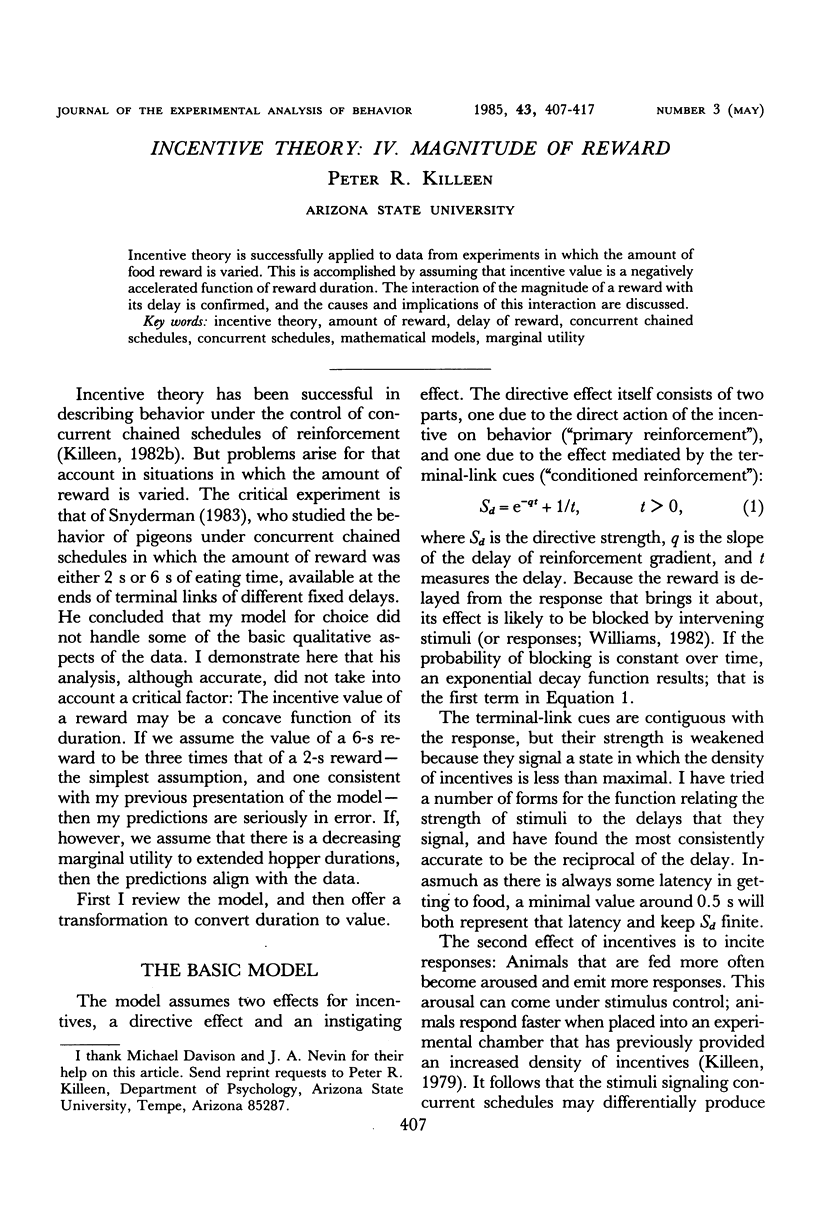
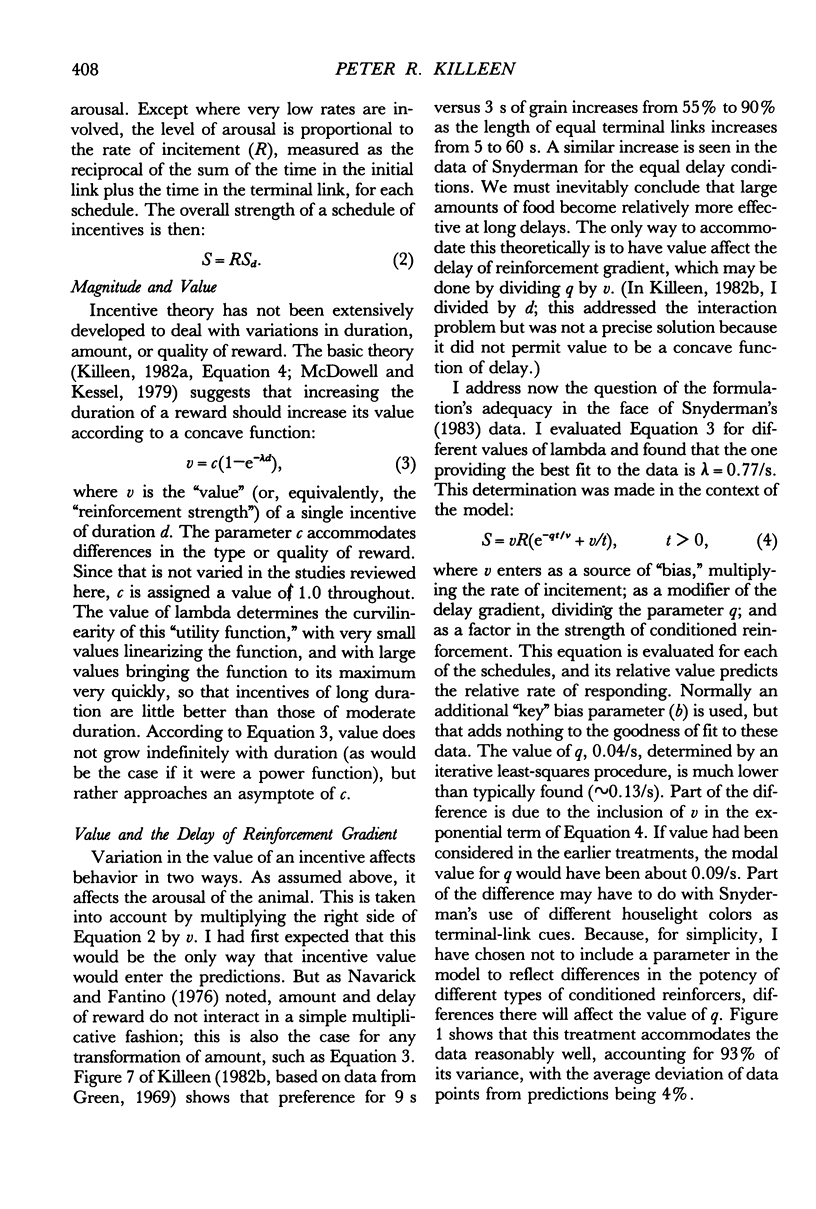
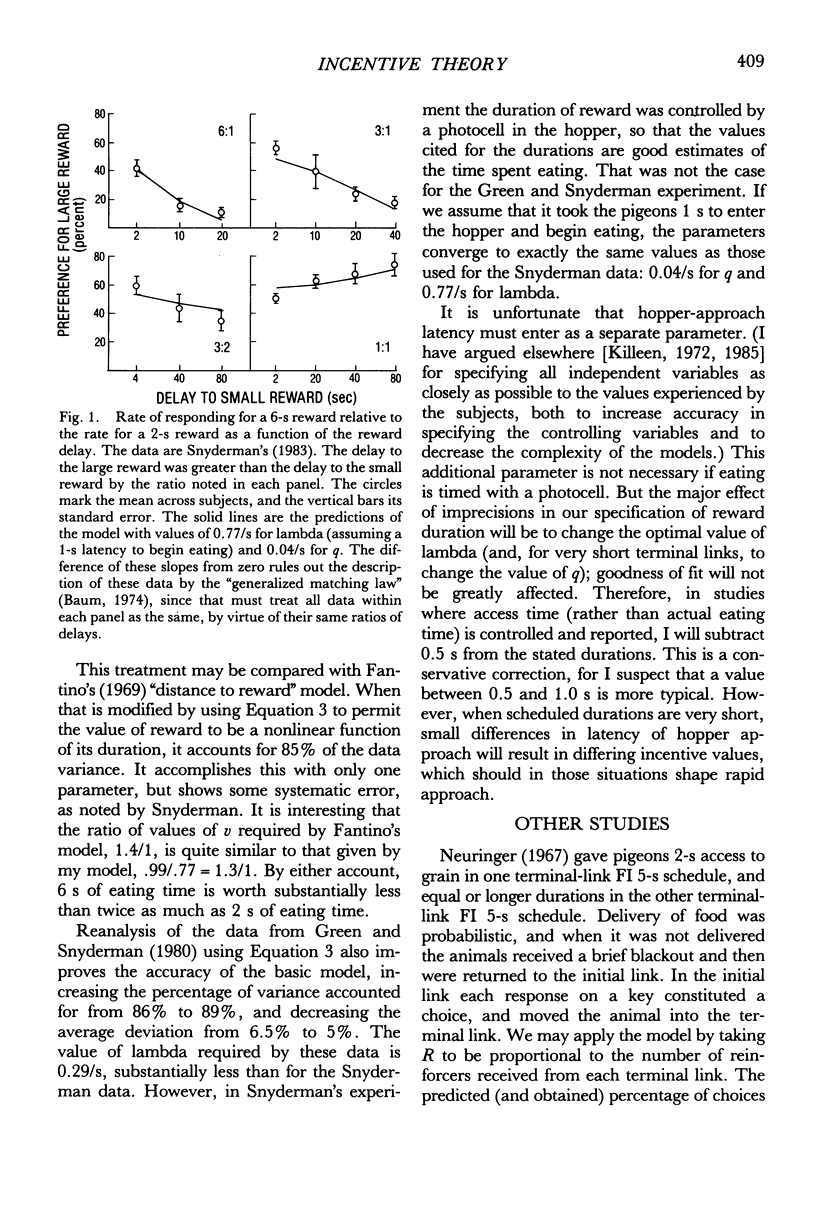
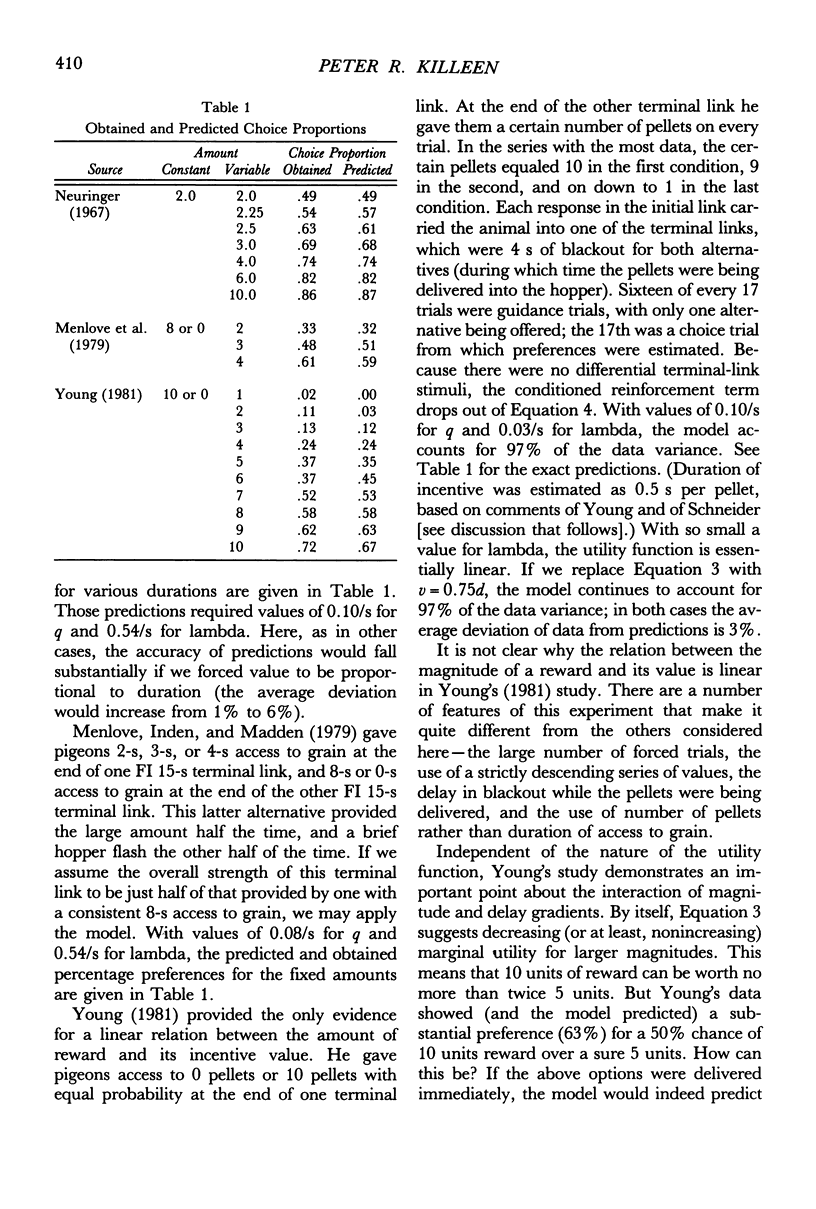
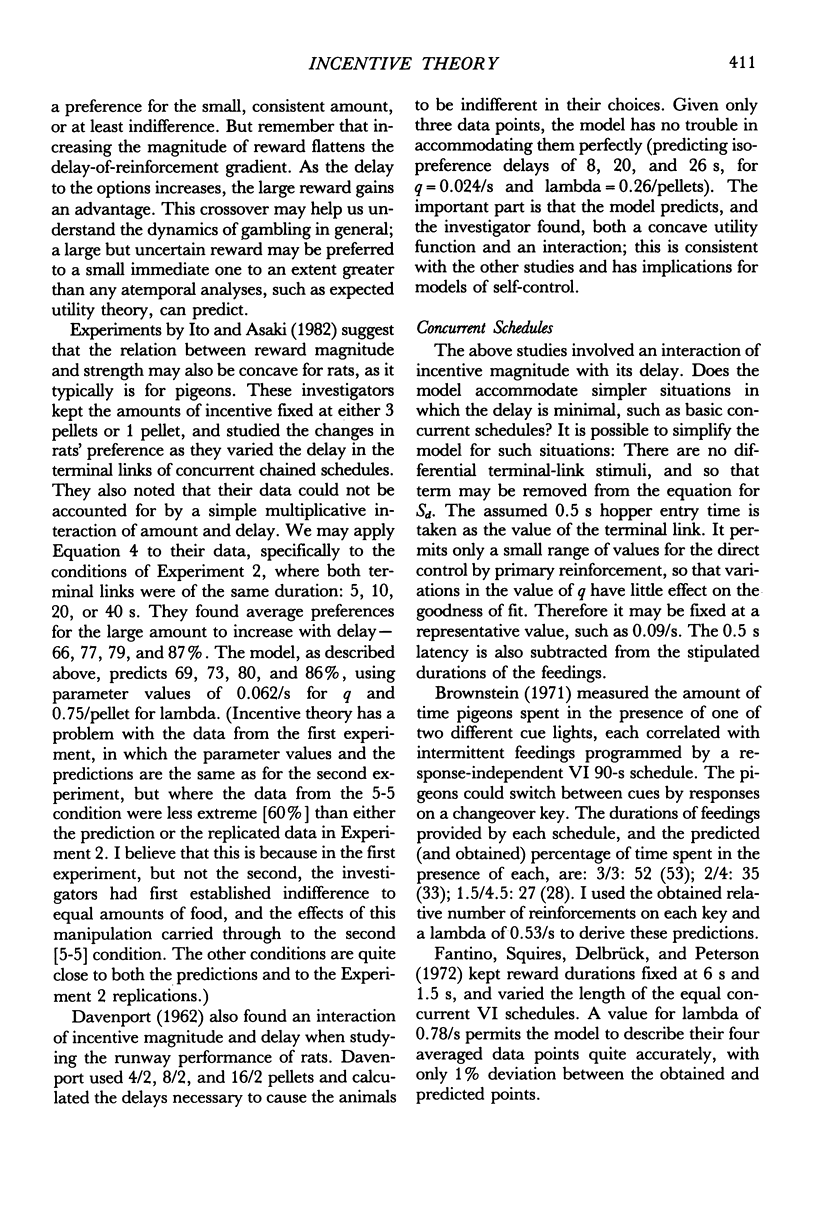
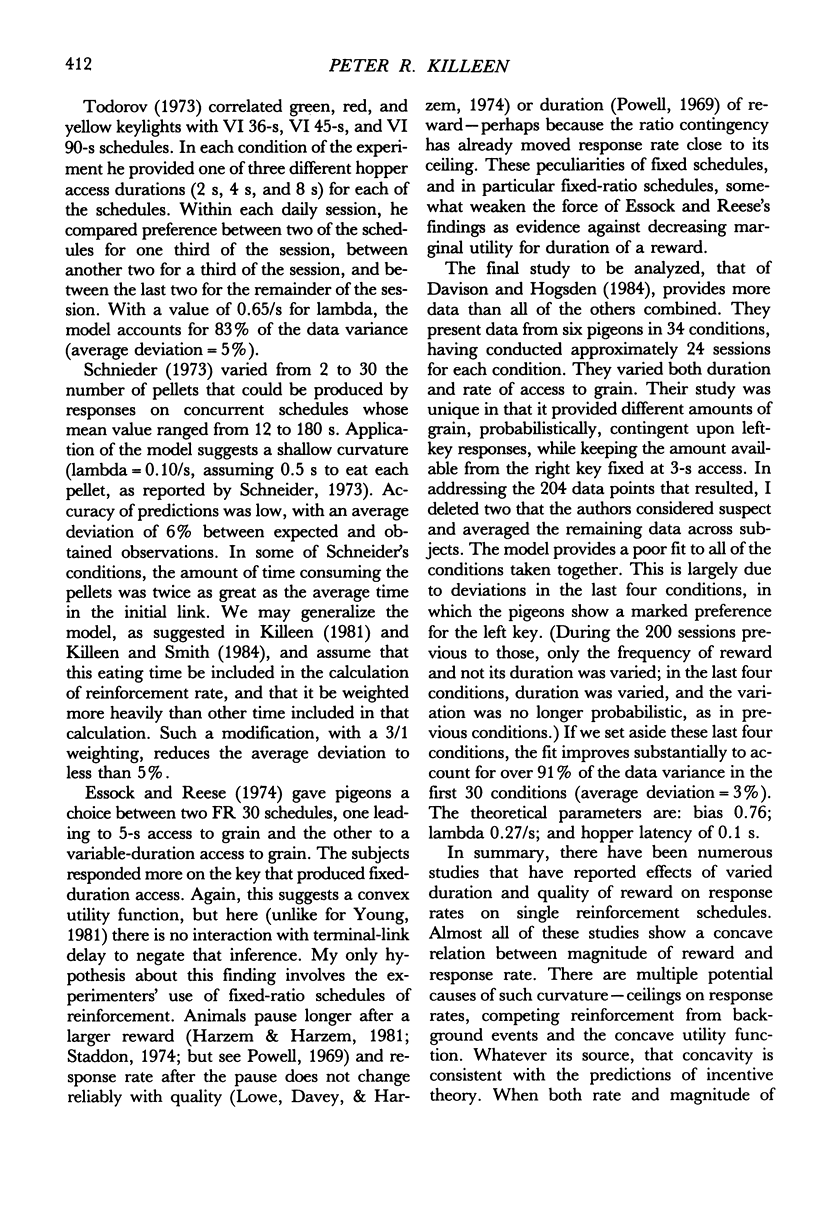
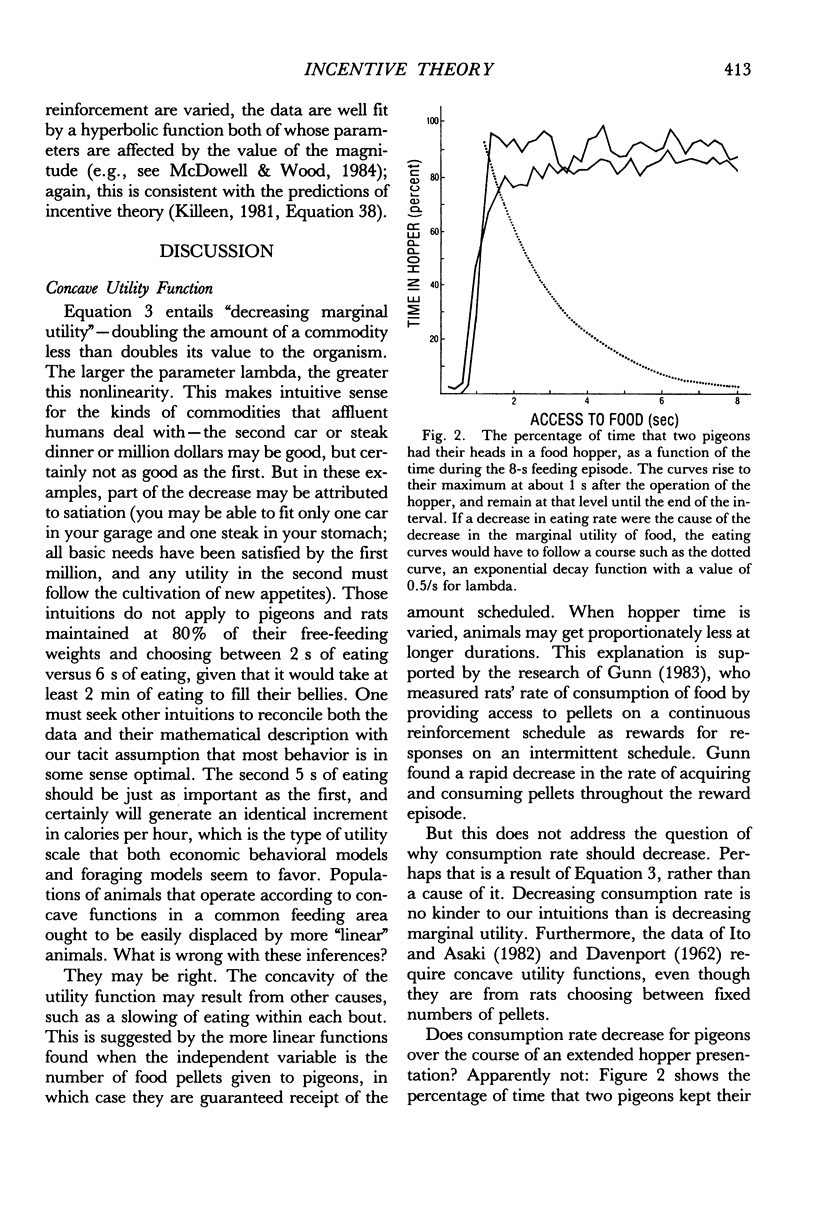
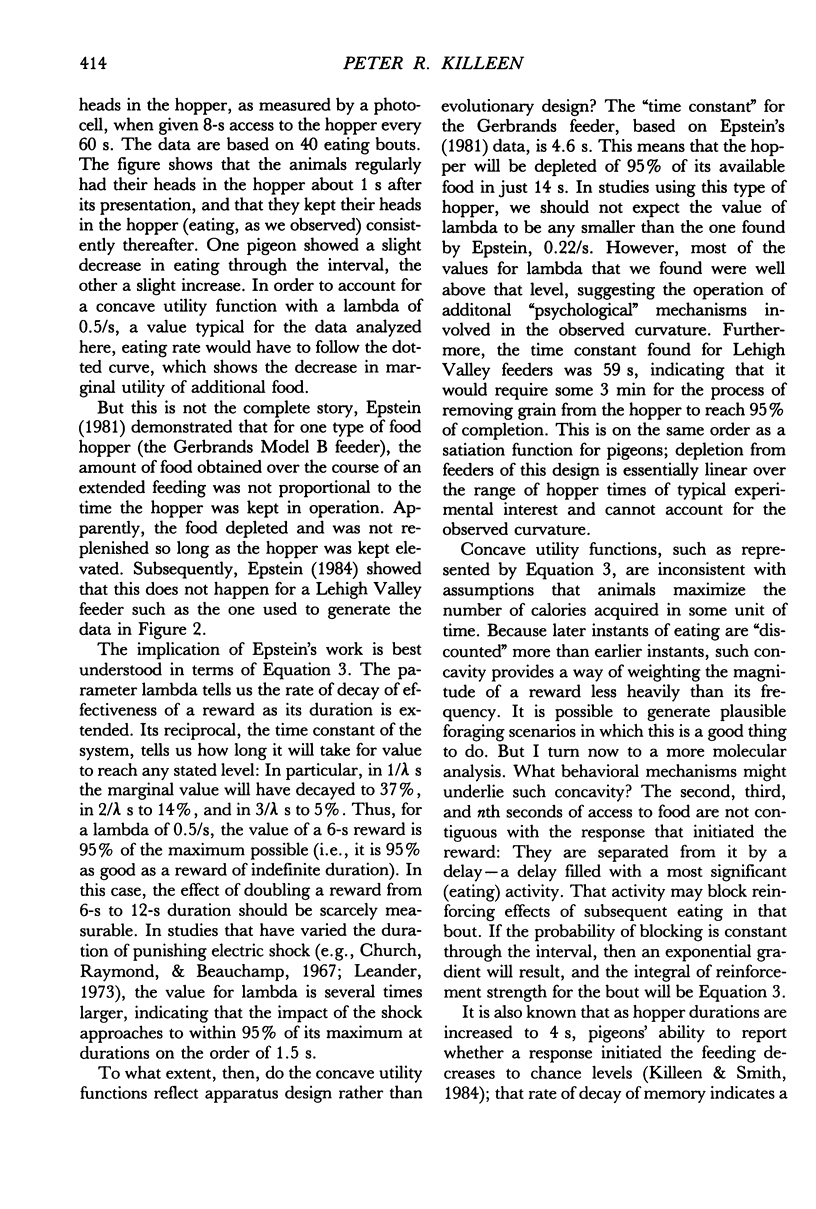
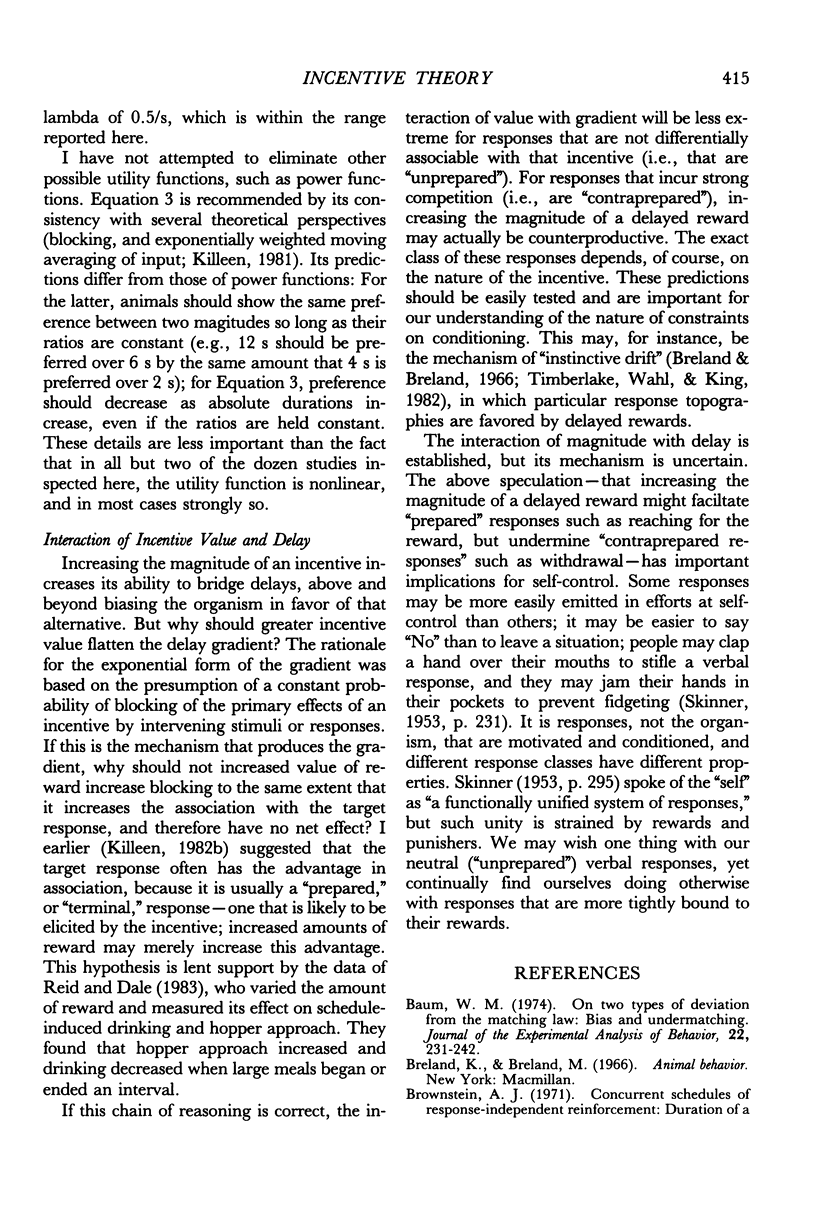
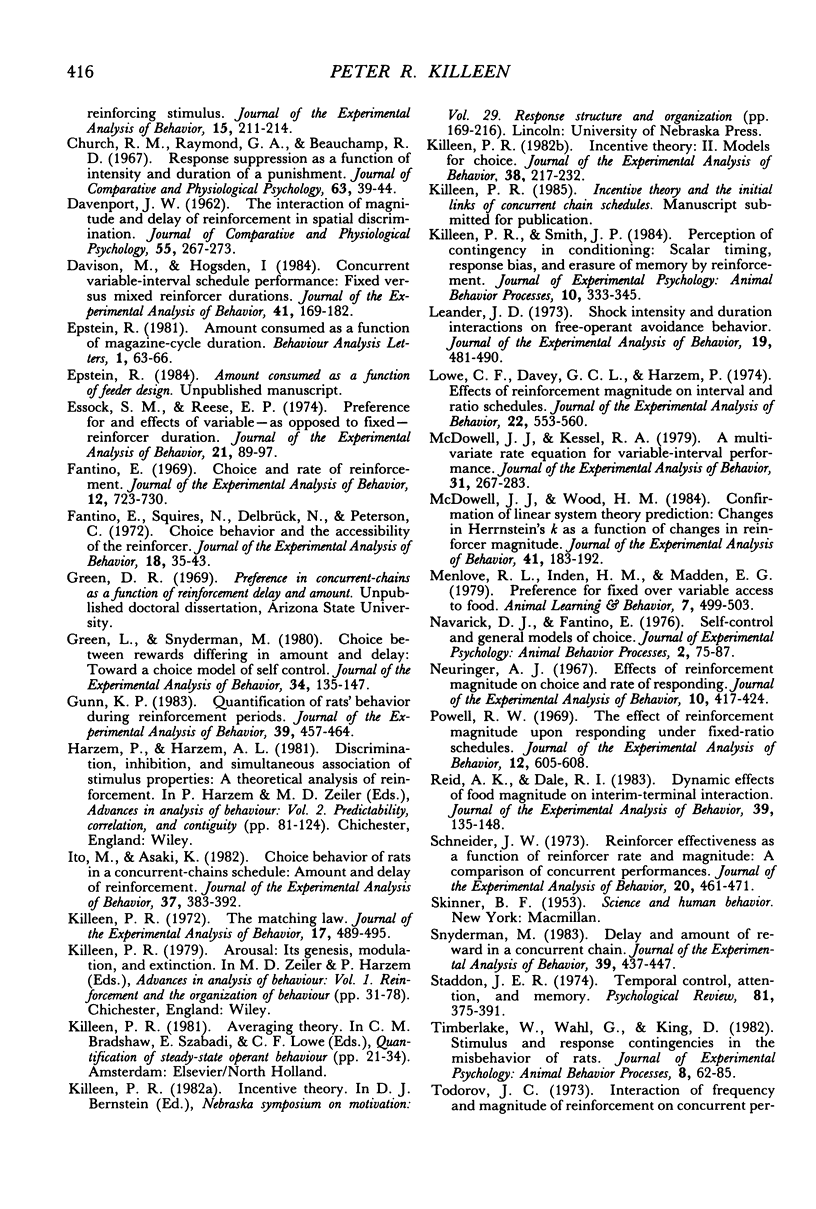
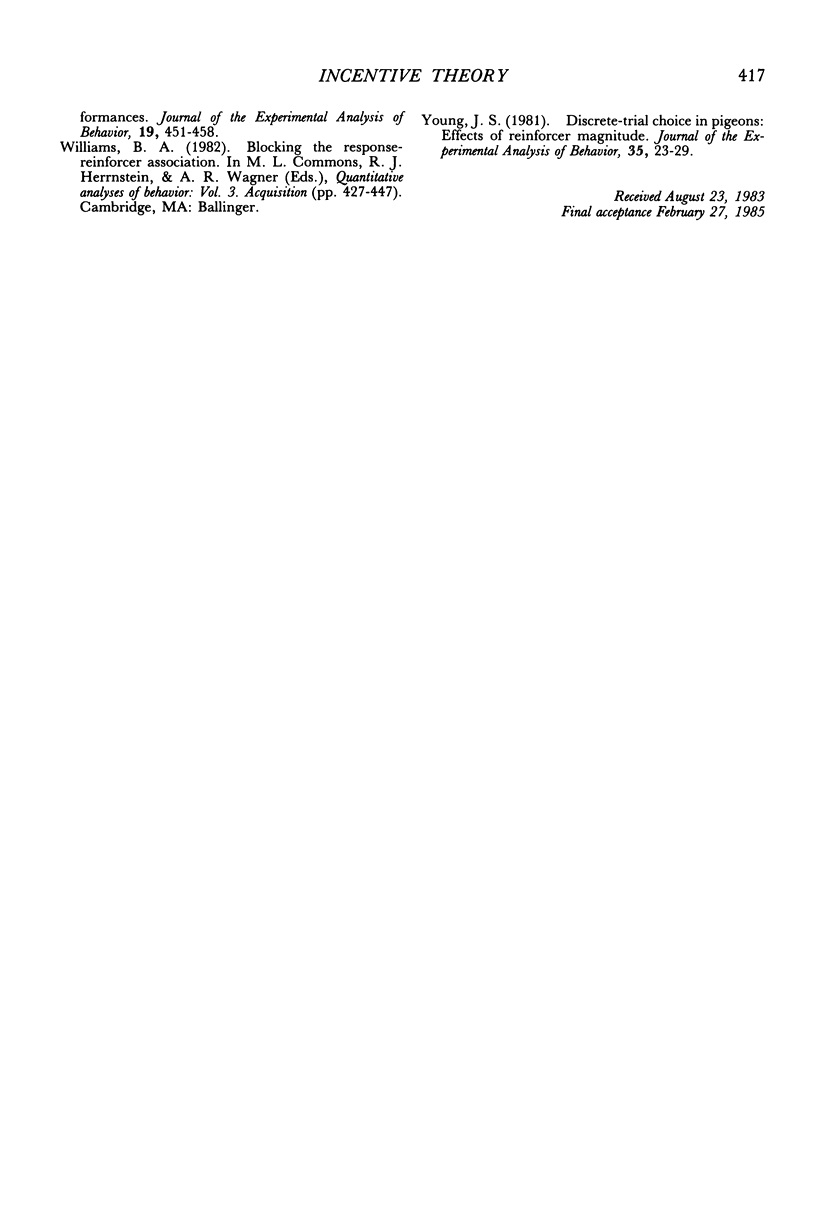
Selected References
These references are in PubMed. This may not be the complete list of references from this article.
- Baum W. M. On two types of deviation from the matching law: bias and undermatching. J Exp Anal Behav. 1974 Jul;22(1):231–242. doi: 10.1901/jeab.1974.22-231. [DOI] [PMC free article] [PubMed] [Google Scholar]
- Brownstein A. J. Concurrent schedules of response-independent reinforcement: duration of a reinforcing stimulus. J Exp Anal Behav. 1971 Mar;15(2):211–214. doi: 10.1901/jeab.1971.15-211. [DOI] [PMC free article] [PubMed] [Google Scholar]
- Church R. M., Raymond G. A., Beauchamp R. D. Response suppression as a function of intensity and duration of a punishment. J Comp Physiol Psychol. 1967 Feb;63(1):39–44. doi: 10.1037/h0024174. [DOI] [PubMed] [Google Scholar]
- DAVENPORT J. W. The interaction of magnitude and delay of reinforcement in spatial discrimination. J Comp Physiol Psychol. 1962 Apr;55:267–273. doi: 10.1037/h0043603. [DOI] [PubMed] [Google Scholar]
- Davison M., Hogsden I. Concurrent variable-interval schedule performance: Fixed versus mixed reinforcer durations. J Exp Anal Behav. 1984 Mar;41(2):169–182. doi: 10.1901/jeab.1984.41-169. [DOI] [PMC free article] [PubMed] [Google Scholar]
- Essock S. M., Reese E. P. Preference for and effects of variable-as opposed to fixed-reinforcer duration. J Exp Anal Behav. 1974 Jan;21(1):89–97. doi: 10.1901/jeab.1974.21-89. [DOI] [PMC free article] [PubMed] [Google Scholar]
- Fantino E. Choice and rate of reinforcement. J Exp Anal Behav. 1969 Sep;12(5):723–730. doi: 10.1901/jeab.1969.12-723. [DOI] [PMC free article] [PubMed] [Google Scholar]
- Fantino E., Squires N., Delbrück N., Peterson C. Choice behavior and the accessibility of the reinforcer. J Exp Anal Behav. 1972 Jul;18(1):35–43. doi: 10.1901/jeab.1972.18-35. [DOI] [PMC free article] [PubMed] [Google Scholar]
- Green L., Snyderman M. Choice between rewards differing in amount and delay: Toward a choice model of self control. J Exp Anal Behav. 1980 Sep;34(2):135–147. doi: 10.1901/jeab.1980.34-135. [DOI] [PMC free article] [PubMed] [Google Scholar]
- Gunn K. P. Quantification of rats' behavior during reinforcement periods. J Exp Anal Behav. 1983 May;39(3):457–464. doi: 10.1901/jeab.1983.39-457. [DOI] [PMC free article] [PubMed] [Google Scholar]
- Ito M., Asaki K. Choice behavior of rats in a concurrent-chains schedule: Amount and delay of reinforcement. J Exp Anal Behav. 1982 May;37(3):383–392. doi: 10.1901/jeab.1982.37-383. [DOI] [PMC free article] [PubMed] [Google Scholar]
- Killeen P. R. Incentive theory: II. Models for choice. J Exp Anal Behav. 1982 Sep;38(2):217–232. doi: 10.1901/jeab.1982.38-217. [DOI] [PMC free article] [PubMed] [Google Scholar]
- Killeen P. The matching law. J Exp Anal Behav. 1972 May;17(3):489–495. doi: 10.1901/jeab.1972.17-489. [DOI] [PMC free article] [PubMed] [Google Scholar]
- Leander J. D. Shock intensity and duration interactions on free-operant avoidance behavior. J Exp Anal Behav. 1973 May;19(3):481–490. doi: 10.1901/jeab.1973.19-481. [DOI] [PMC free article] [PubMed] [Google Scholar]
- Lowe C. F., Davey G. C., Harzem P. Effects of reinforcement magnitude on interval and ratio schedules. J Exp Anal Behav. 1974 Nov;22(3):553–560. doi: 10.1901/jeab.1974.22-553. [DOI] [PMC free article] [PubMed] [Google Scholar]
- McDowell J. J., Kessel R. A multivariate rate equation for variable-interval performance. J Exp Anal Behav. 1979 Mar;31(2):267–283. doi: 10.1901/jeab.1979.31-267. [DOI] [PMC free article] [PubMed] [Google Scholar]
- McDowell J. J., Wood H. M. Confirmation of linear system theory prediction: Changes in Herrnstein's k as a function of changes in reinforcer magnitude. J Exp Anal Behav. 1984 Mar;41(2):183–192. doi: 10.1901/jeab.1984.41-183. [DOI] [PMC free article] [PubMed] [Google Scholar]
- Neuringer A. J. Effects of reinforcement magnitude on choice and rate of responding. J Exp Anal Behav. 1967 Sep;10(5):417–424. doi: 10.1901/jeab.1967.10-417. [DOI] [PMC free article] [PubMed] [Google Scholar]
- Powell R. W. The effect of reinforcement magnitude upon responding under fixed-ratio schedules. J Exp Anal Behav. 1969 Jul;12(4):605–608. doi: 10.1901/jeab.1969.12-605. [DOI] [PMC free article] [PubMed] [Google Scholar]
- Reid A. K., Dale R. H. Dynamic effects of food magnitude on interim-terminal interaction. J Exp Anal Behav. 1983 Jan;39(1):135–148. doi: 10.1901/jeab.1983.39-135. [DOI] [PMC free article] [PubMed] [Google Scholar]
- Schneider J. W. Reinforcer effectiveness as a function of reinforcer rate and magnitude: a comparison of concurrent performances. J Exp Anal Behav. 1973 Nov;20(3):461–471. doi: 10.1901/jeab.1973.20-461. [DOI] [PMC free article] [PubMed] [Google Scholar]
- Snyderman M. Delay and amount of reward in a concurrent chain. J Exp Anal Behav. 1983 May;39(3):437–447. doi: 10.1901/jeab.1983.39-437. [DOI] [PMC free article] [PubMed] [Google Scholar]
- Timberlake W., Wahl G., King D. Stimulus and response contingencies in the misbehavior of rats. J Exp Psychol Anim Behav Process. 1982 Jan;8(1):62–85. [PubMed] [Google Scholar]
- Todorov J. C. Interaction of frequency and magnitude of reinforcement on concurrent performances. J Exp Anal Behav. 1973 May;19(3):451–458. doi: 10.1901/jeab.1973.19-451. [DOI] [PMC free article] [PubMed] [Google Scholar]
- Young J. S. Discrete-trial choice in pigeons: Effects of reinforcer magnitude. J Exp Anal Behav. 1981 Jan;35(1):23–29. doi: 10.1901/jeab.1981.35-23. [DOI] [PMC free article] [PubMed] [Google Scholar]


